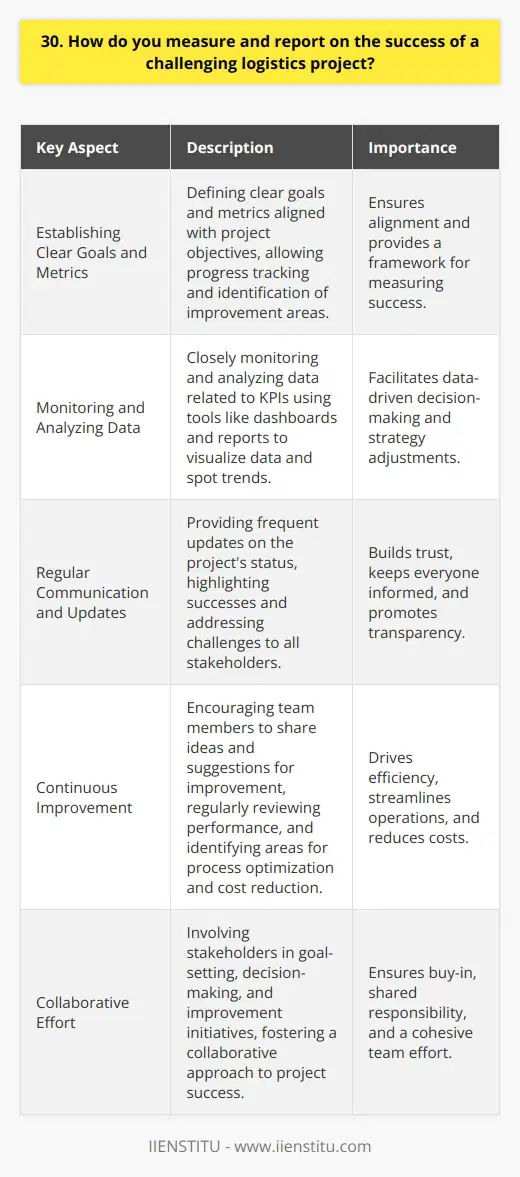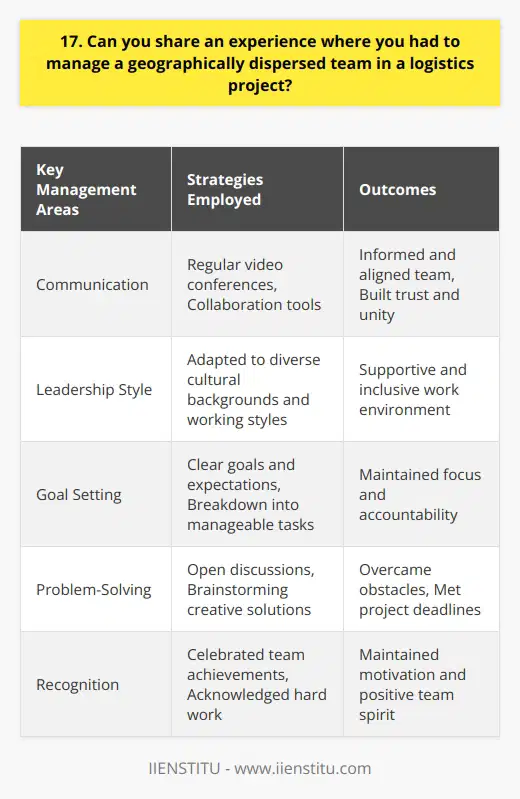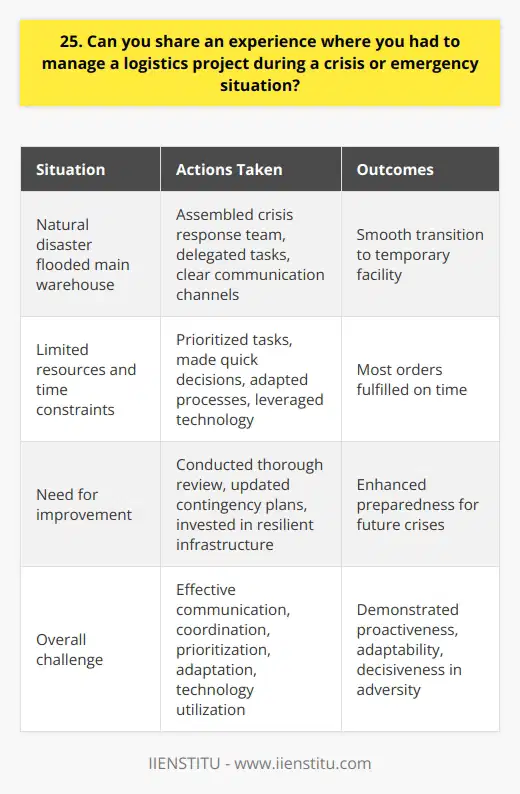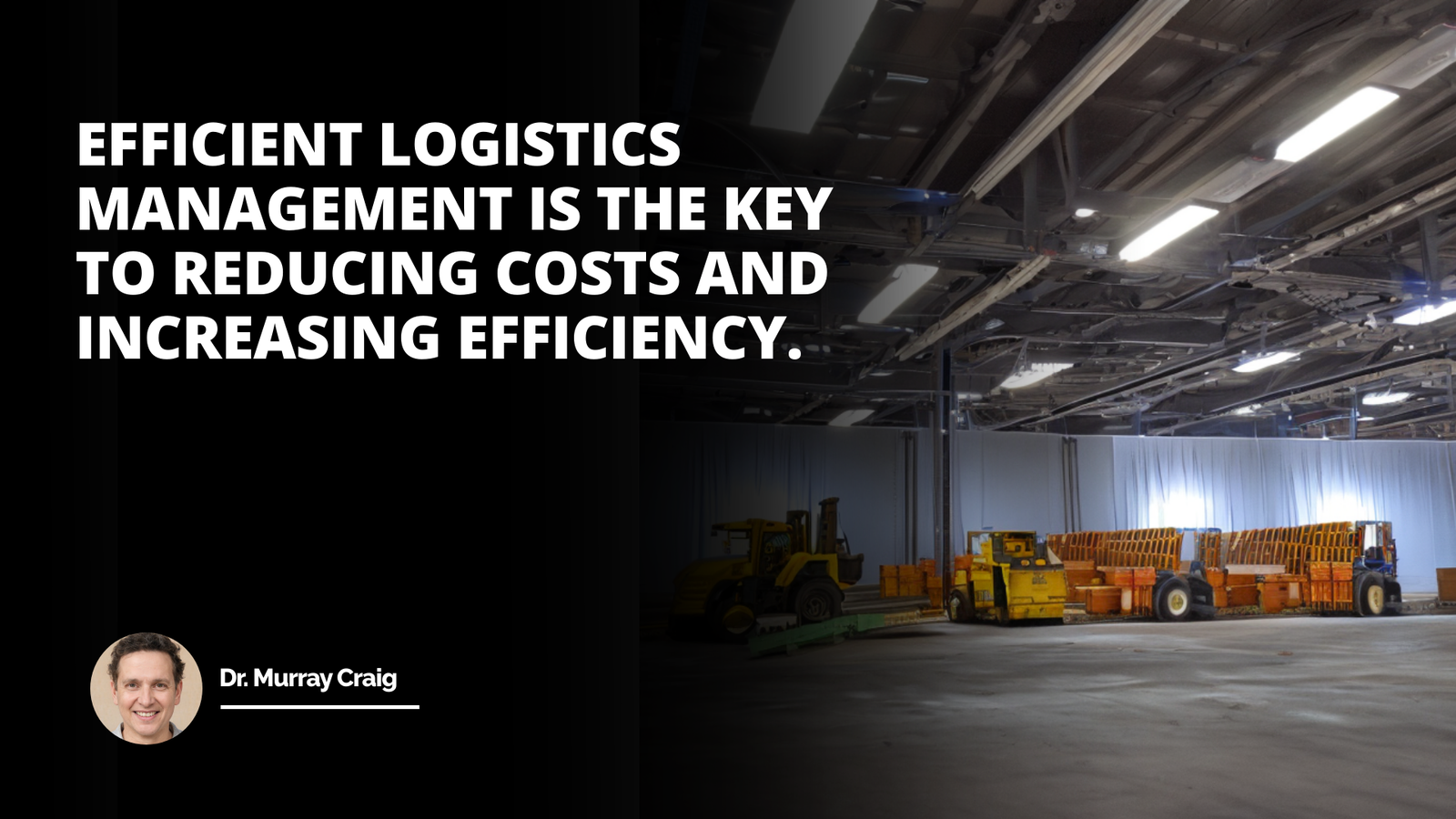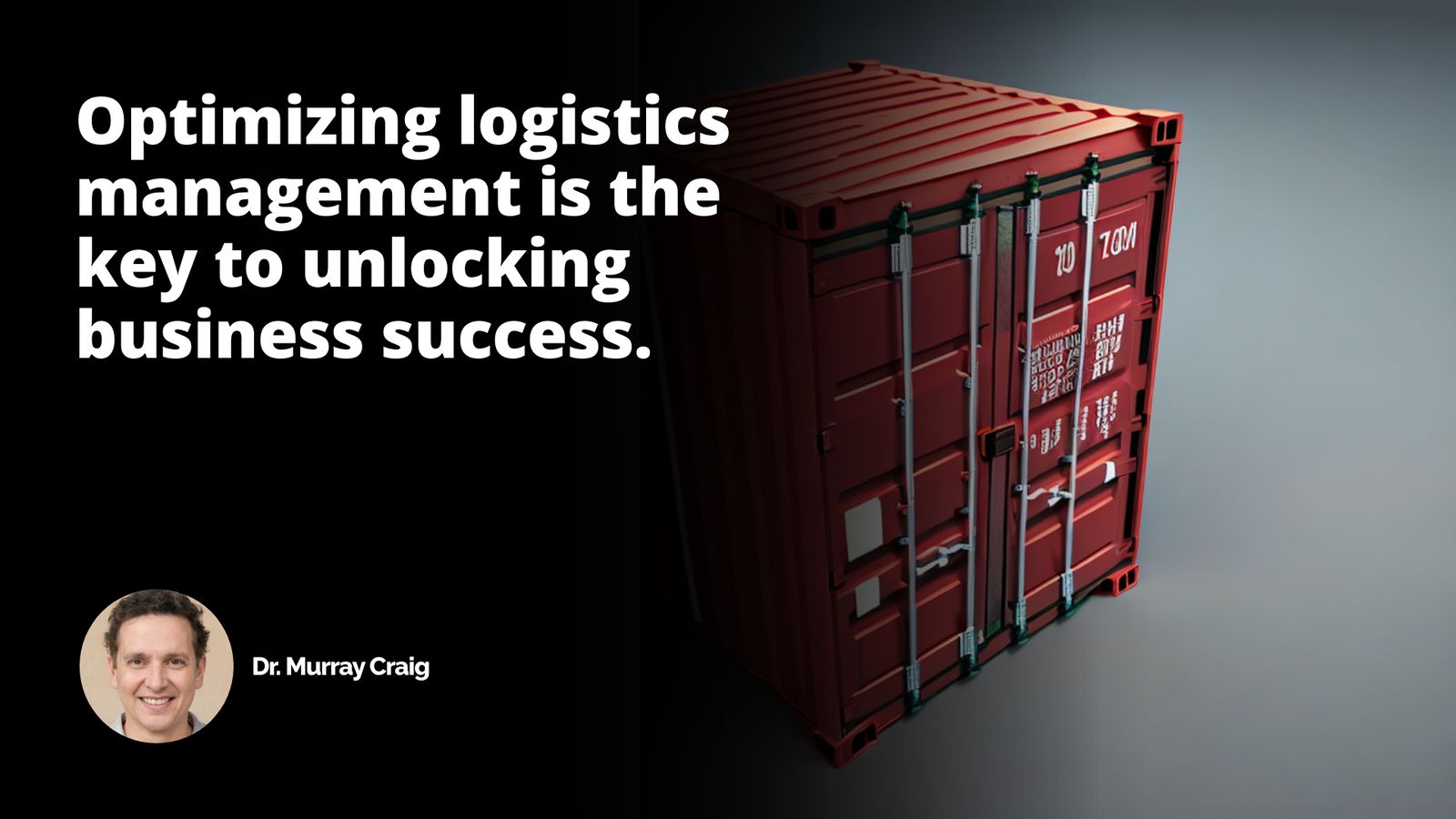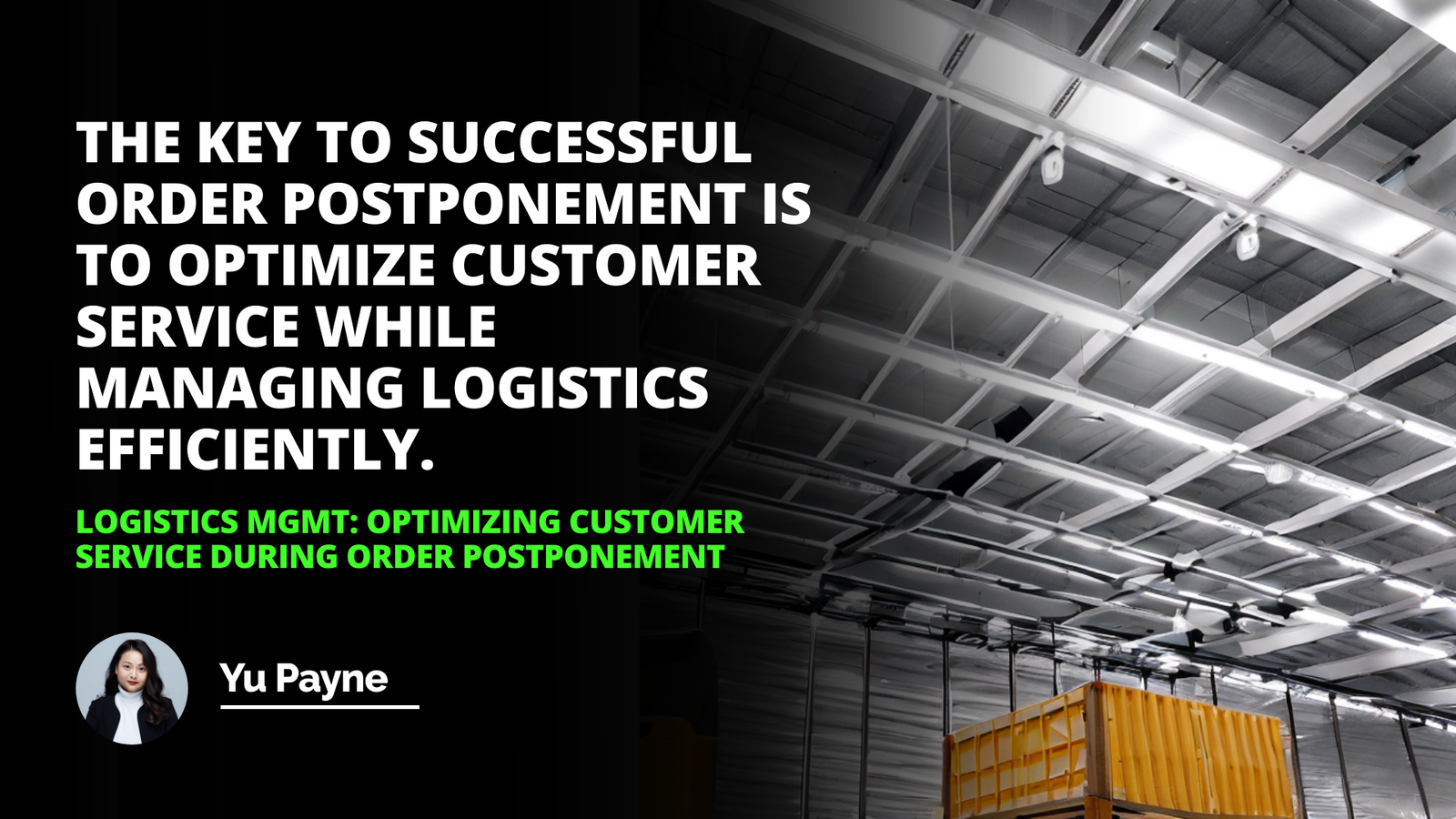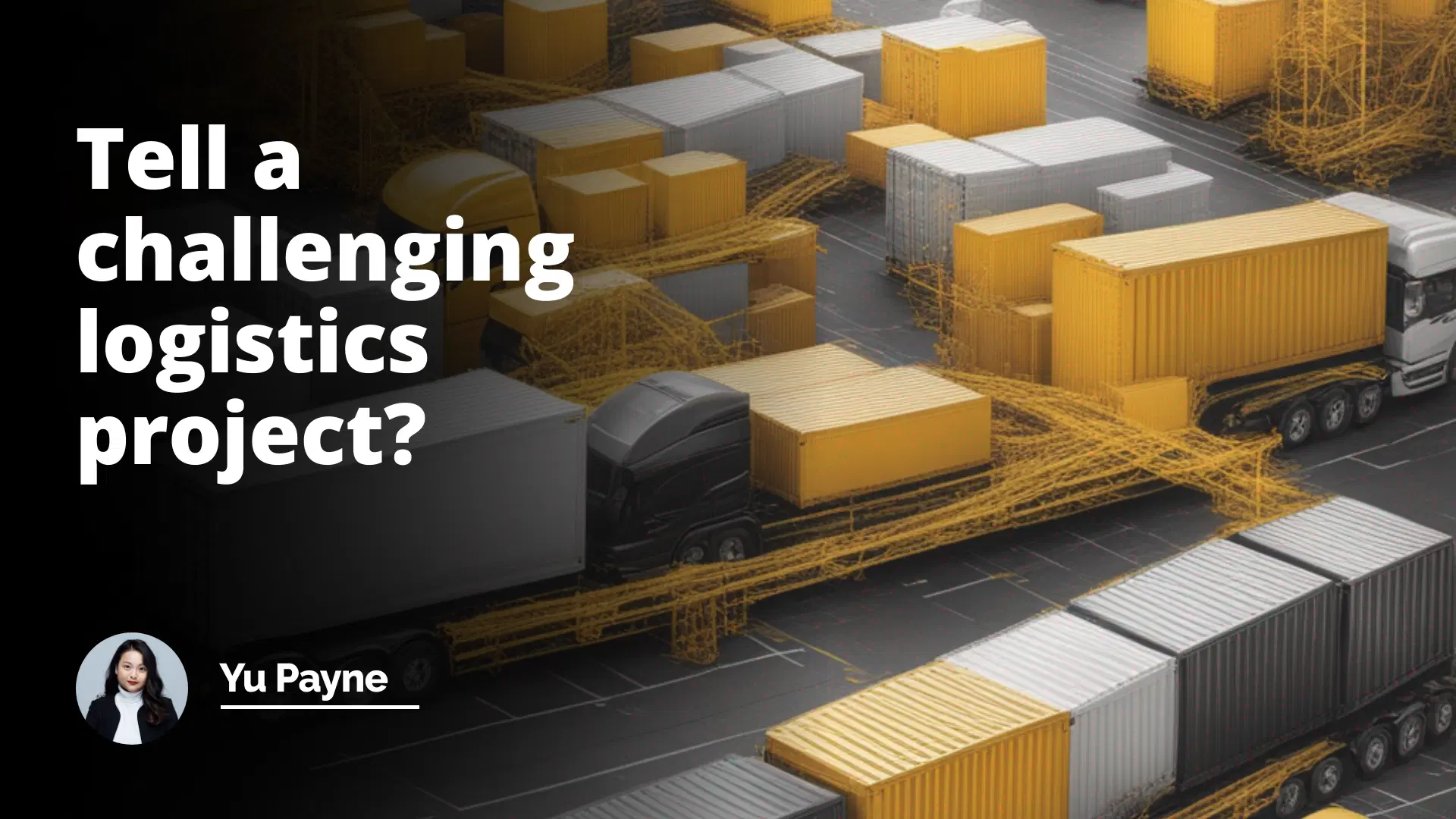
Navigating the complex world of logistics can be a daunting task, especially when faced with challenging projects that test your skills, knowledge, and experience. As an employer, it's crucial to delve into a candidate's ability to handle these demanding situations during the interview process. The question, "Tell me about a challenging logistics project," is a powerful tool that can reveal a wealth of information about a potential employee's problem-solving abilities, technical expertise, communication skills, and leadership qualities.
When I reflect on my own career in logistics, one particular project stands out as a true test of my abilities. It was during my time as a logistics manager at ABC Global, a multinational corporation specializing in consumer goods. We were tasked with optimizing the supply chain network for our European operations, which spanned across 15 countries. The project was complex, involving numerous stakeholders, varying regulations, and tight deadlines.
The first challenge we faced was data integration. Each country had its own ERP system, which meant that consolidating and standardizing the data was a monumental task. As Phillips (2019) points out in his book "Supply Chain Analytics," data quality and consistency are critical for effective supply chain optimization (p. 57). We spent countless hours working with IT teams across the continent to ensure that we had a reliable and unified data set to work with.
Once we had the data in place, we began the process of network modeling and optimization. We utilized advanced analytics tools to simulate various scenarios and identify potential bottlenecks in the supply chain. As mentioned in "Network Optimization in Supply Chain Management" by Ravindran and Warsing (2013), network optimization involves finding the most efficient way to move products from suppliers to customers while minimizing costs and maximizing service levels (p. 23). It was a complex process that required close collaboration between our logistics, finance, and operations teams.
One of the most significant challenges we encountered was managing the expectations of various stakeholders. Each country had its own priorities and constraints, which often conflicted with the overall objectives of the project. As a logistics manager, it was my responsibility to navigate these competing interests and find a solution that worked for everyone. It required a great deal of diplomacy, negotiation, and communication skills. As Hartley (2018) notes in "Communication in Global Business," effective communication is essential for managing cross-cultural teams and aligning stakeholders towards a common goal (p. 89).
Despite the challenges, we were able to successfully implement the optimized supply chain network across Europe. The results were impressive: we reduced transportation costs by 15%, improved inventory turns by 20%, and increased on-time delivery rates to 98%. It was a testament to the hard work and dedication of the entire team.
Looking back on this project, I realized that one of the most important factors in its success was our ability to adapt and innovate in the face of adversity. As Simchi-Levi et al. (2014) point out in "Designing and Managing the Supply Chain," logistics professionals must be able to think creatively and find new solutions to complex problems (p. 143). Throughout the project, we encountered numerous obstacles that required us to think outside the box and come up with innovative approaches.
For example, when we realized that our existing transportation providers were unable to meet our new requirements, we decided to explore alternative options. We ended up partnering with a startup that specialized in on-demand delivery services, which allowed us to reduce our lead times and improve our responsiveness to customer demands. It was a risk, but it paid off in the end.
Another key lesson I learned from this project was the importance of continuous improvement. Even after we had implemented the new supply chain network, we continued to monitor its performance and identify areas for improvement. As Goldratt and Cox (2014) emphasize in "The Goal," the pursuit of perfection is an ongoing process that requires a commitment to learning and growth (p. 67). We regularly conducted kaizen events and solicited feedback from our stakeholders to ensure that we were always striving to be better.
Can you describe a logistics project that posed a significant challenge for you?
Have you encountered any challenging logistics projects recently?
Can you provide an example of a logistics project that notably tested your abilities?
Could you share your experience on a most challenging project in logistics that you've handled?
Can you elucidate on a logistics project that pushed you outside of your comfort zone?
What has been your most challenging logistics project up to date?
What hurdles did you face in a particularly challenging logistics project?
Do you recall a particularly demanding project in the logistics sector that challenged your skills?
What has been one of the most complex projects in logistics you have worked on?
Could you describe a time when you had to deal with a challenging situation in a logistics project?
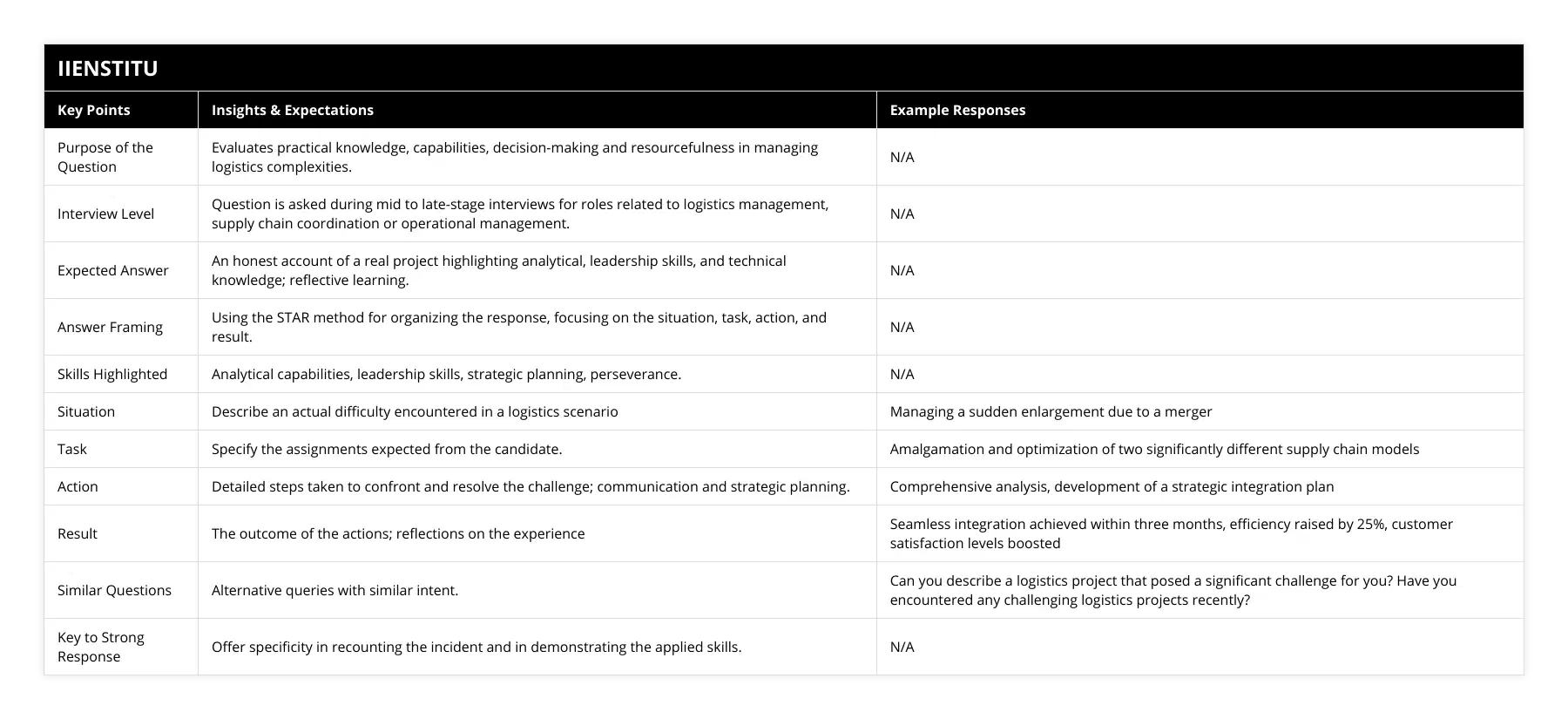
In conclusion, managing a challenging logistics project requires a unique combination of technical expertise, strategic thinking, communication skills, and leadership abilities. It's a role that demands resilience, adaptability, and a willingness to take risks. As a logistics professional, I have learned that success in this field is not just about optimizing routes or reducing costs, but about building relationships, fostering innovation, and continuously improving processes.
When asked about a challenging logistics project in an interview, it's essential to provide specific examples that demonstrate your problem-solving skills, technical knowledge, and ability to lead cross-functional teams. Use the STAR method (Situation, Task, Action, Result) to structure your response and highlight the impact of your contributions. Share the lessons you learned and how you have applied them to subsequent projects.
Remember, the interviewer is not just interested in the project itself, but in how you approached the challenges and what you learned from the experience. They want to see that you have the skills and mindset required to tackle the complex problems that logistics professionals face on a daily basis.
In today's rapidly evolving business environment, logistics is more important than ever. Companies are looking for individuals who can help them navigate the complexities of global supply chains, optimize their operations, and deliver value to their customers. By showcasing your ability to handle challenging logistics projects, you demonstrate that you have what it takes to succeed in this dynamic field.
So, the next time you're asked about a challenging logistics project in an interview, take a deep breath and reflect on your experiences. Think about the obstacles you faced, the actions you took, and the results you achieved. Share your story with confidence and passion, and show the interviewer that you're ready to take on whatever challenges come your way.
References:
1- Goldratt, E. M., & Cox, J. (2014). The Goal: A Process of Ongoing Improvement. 30th Anniversary Edition. North River Press.
2- Hartley, J. L. (2018). Communication in Global Business: Strategies for Success in the Digital Age. Cambridge University Press.
3- Phillips, F. (2019). Supply Chain Analytics: Harnessing the Power of Data for Competitive Advantage. Kogan Page.
4- Ravindran, A. R., & Warsing, D. P. (2013). Network Optimization in Supply Chain Management. CRC Press.
5- Simchi-Levi, D., Kaminsky, P., & Simchi-Levi, E. (2014). Designing and Managing the Supply Chain: Concepts, Strategies, and Case Studies. McGraw-Hill Education.
Frequently Asked Questions
1. How do you handle unexpected delays in a logistics project?
When faced with unexpected delays in a logistics project, I first assess the situation calmly and objectively. I gather all the relevant information to understand the root cause of the delay and its potential impact.
Communicating with Stakeholders
I promptly inform all stakeholders about the delay, including clients, suppliers, and team members. Transparency is key to maintaining trust and cooperation. I explain the reasons for the delay and provide a realistic timeline for resolving the issue.
Developing a Contingency Plan
Next, I work with my team to develop a contingency plan. We brainstorm alternative solutions and prioritize actions based on their feasibility and effectiveness. I encourage everyone to think creatively and explore unconventional approaches if necessary.
Implementing Solutions
Once we have a clear action plan, I allocate resources and assign responsibilities to ensure swift implementation. I closely monitor progress and make adjustments as needed. I also maintain open lines of communication with all parties involved to keep them updated on the status of the project.
Learning from Experience
After the delay is resolved, I conduct a thorough post-mortem analysis with my team. We identify the lessons learned and discuss how we can prevent similar issues from occurring in the future. I believe that every challenge is an opportunity for growth and improvement.
In my previous role at XYZ Logistics, I successfully handled a significant delay caused by a supplier's production issues. By quickly implementing a contingency plan and collaborating closely with our client, we were able to minimize the impact on the overall project timeline. The experience taught me the importance of proactive communication and creative problem-solving in logistics management.
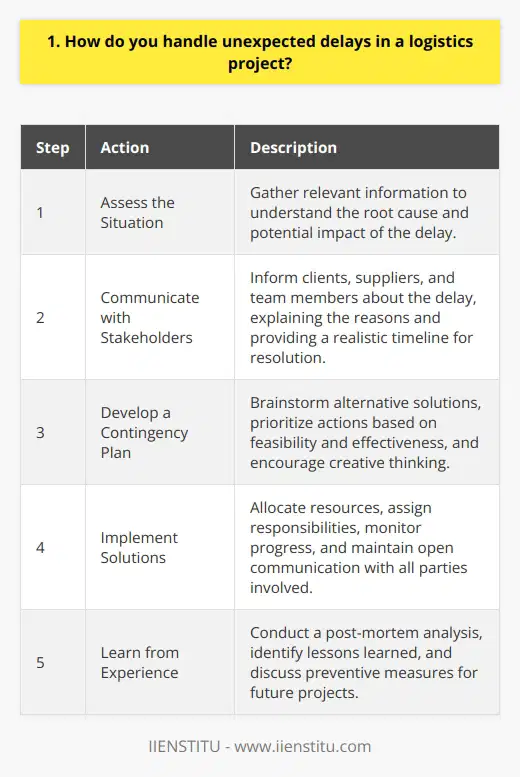
2. Can you describe a time when you had to manage multiple stakeholders in a logistics project?
I once managed a complex logistics project involving multiple stakeholders, each with their own unique requirements and expectations. It was a challenging experience, but also incredibly rewarding.
Identifying Stakeholders and Their Needs
The first step was to identify all the key players. This included our clients, suppliers, and internal departments. I met with each group to understand their specific needs and concerns.
Listening actively and empathetically was crucial. I aimed to build trust and rapport with everyone involved.
Developing a Comprehensive Plan
With a clear understanding of each stakeholder's requirements, I developed a detailed project plan. This outlined timelines, milestones, and responsibilities. I made sure to get buy-in from all parties before proceeding.
The plan was a living document. I updated it regularly as the project evolved and new challenges emerged.
Communicating Regularly and Transparently
Throughout the project, I maintained open lines of communication with all stakeholders. I provided regular status updates, highlighting progress and any issues that needed attention.
When conflicts arose, as they inevitably do, I brought the relevant parties together to find mutually beneficial solutions. I acted as a mediator, helping everyone understand each other's perspectives.
Staying Flexible and Adaptable
Despite careful planning, unexpected challenges still cropped up. A key supplier experienced a production delay, throwing our timeline off track.
Rather than panic, I worked with the team to find creative solutions. We sourced alternative suppliers and adjusted our schedule. By staying flexible, we were able to keep the project moving forward.
Celebrating Success and Learning from Mistakes
In the end, we delivered the project on time and within budget. It was a huge success, and I made sure to celebrate with the entire team.
But I also took time to reflect on the lessons learned. There were definitely areas where we could improve for next time. Managing multiple stakeholders is always a balancing act, but with the right approach, it's possible to keep everyone happy and achieve great results.
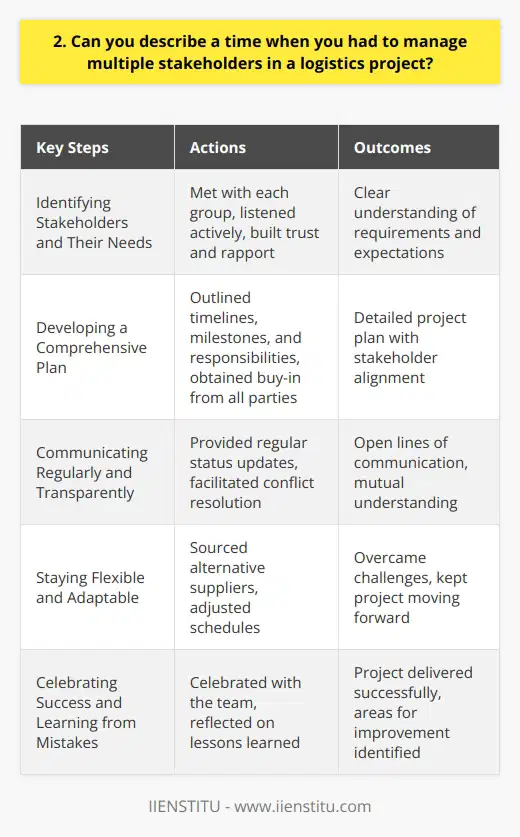
3. What strategies do you use to ensure effective communication in a challenging logistics project?
I believe that effective communication is the foundation of success in any logistics project, especially when facing challenges. I employ several strategies to ensure that all stakeholders are on the same page and working towards a common goal.
Active Listening
First and foremost, I practice active listening. I give my full attention to the person speaking and try to understand their perspective. I ask clarifying questions and paraphrase their message to ensure that I have understood correctly.
Clear and Concise Messages
When conveying information, I strive to be clear and concise. I avoid jargon and use simple language that everyone can understand. I break down complex ideas into smaller, more digestible chunks.
Tailoring Communication Style
I also adapt my communication style to suit the preferences of different stakeholders. Some people prefer email, while others prefer face-to-face meetings or phone calls. I try to accommodate their preferences whenever possible.
Regular Check-Ins
Throughout the project, I schedule regular check-ins with team members and stakeholders. These meetings provide an opportunity to discuss progress, identify potential issues, and brainstorm solutions. They also help to build trust and foster a sense of teamwork.
In my experience, these strategies have been effective in ensuring smooth communication and successful project outcomes. I remember one particularly challenging project where we were facing tight deadlines and budget constraints. By employing these communication techniques, we were able to identify and resolve issues quickly, and ultimately deliver the project on time and within budget.
Effective communication is not always easy, but it is essential for success in logistics. By actively listening, conveying clear messages, adapting to different styles, and regularly checking in, I strive to ensure that everyone is working together effectively towards our common goal.
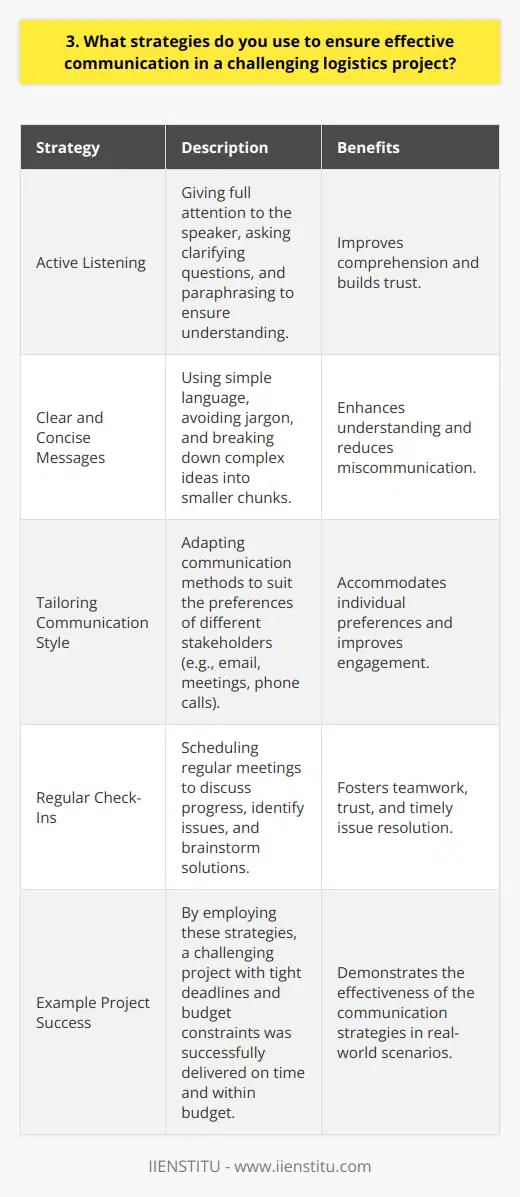
4. How do you prioritize tasks and resources when faced with competing demands in a logistics project?
When faced with competing demands in a logistics project, I prioritize tasks based on their impact and urgency. I assess which tasks are critical for meeting project goals and deadlines. Then, I allocate resources accordingly, ensuring that high-priority tasks receive the necessary attention and support.
Effective Communication is Key
I maintain open lines of communication with project stakeholders to stay informed about changing priorities. Regular updates help me adjust task allocations and resource assignments as needed. Collaboration with team members is essential for identifying potential bottlenecks and finding efficient solutions.
Flexibility and Adaptability are Essential
In my experience, logistics projects often encounter unexpected challenges that require quick thinking and decisive action. I remain flexible in my approach, ready to pivot strategies when necessary. Adaptability is crucial for keeping the project moving forward despite competing demands.
Leveraging Technology for Efficiency
I leverage project management tools and software to streamline task prioritization and resource allocation. These tools provide real-time visibility into project progress, enabling me to make data-driven decisions. Automation of routine tasks frees up time for focusing on high-impact activities.
Continuous Improvement is a Priority
I believe in continuously improving processes to optimize efficiency and minimize competing demands. I actively seek feedback from team members and stakeholders to identify areas for improvement. Implementing lessons learned from previous projects helps me anticipate and mitigate potential conflicts in task and resource allocation.
By prioritizing effectively, communicating openly, staying flexible, leveraging technology, and continuously improving, I successfully navigate competing demands in logistics projects. My goal is always to deliver successful outcomes while optimizing resources and meeting critical deadlines.
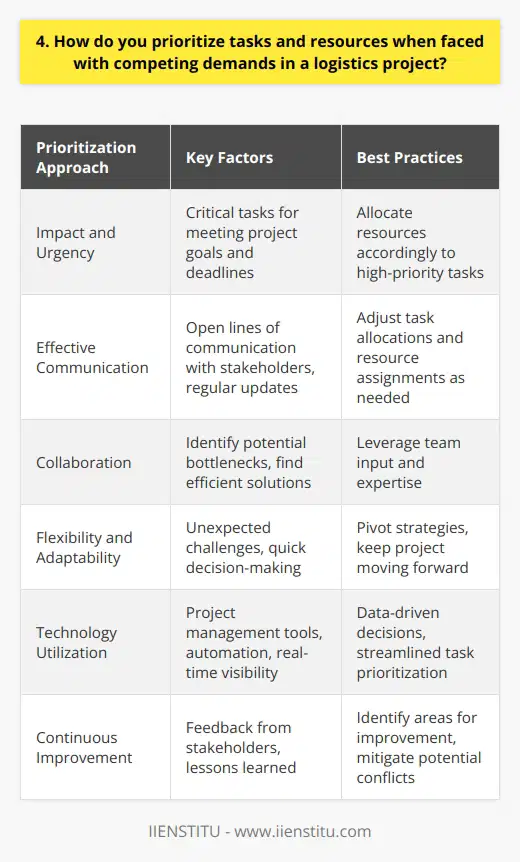
5. Can you give an example of how you resolved a conflict within a logistics project team?
In my previous role as a logistics project manager, I encountered a conflict between two team members. The disagreement stemmed from differing opinions on how to prioritize tasks and allocate resources.
Listening to Both Sides
I scheduled a meeting with both individuals to understand their perspectives. I actively listened to their concerns and made sure they felt heard. This helped to defuse the tension and create an open dialogue.
Finding Common Ground
During the discussion, I guided the conversation towards identifying shared goals and objectives. By focusing on what they agreed on, rather than their differences, we found a foundation for compromise.
Brainstorming Solutions
I encouraged the team members to brainstorm potential solutions together. We explored various options and evaluated the pros and cons of each approach. This collaborative problem-solving fostered a sense of teamwork and ownership.
Reaching a Consensus
Through open communication and a willingness to find a middle ground, we reached a mutually agreeable solution. We prioritized tasks based on urgency and impact, while ensuring a fair distribution of resources. Both team members felt satisfied with the outcome.
This experience taught me the importance of active listening, finding common ground, and facilitating collaborative problem-solving. By addressing conflicts promptly and constructively, we maintained a positive team dynamic and successfully delivered the project on time and within budget.
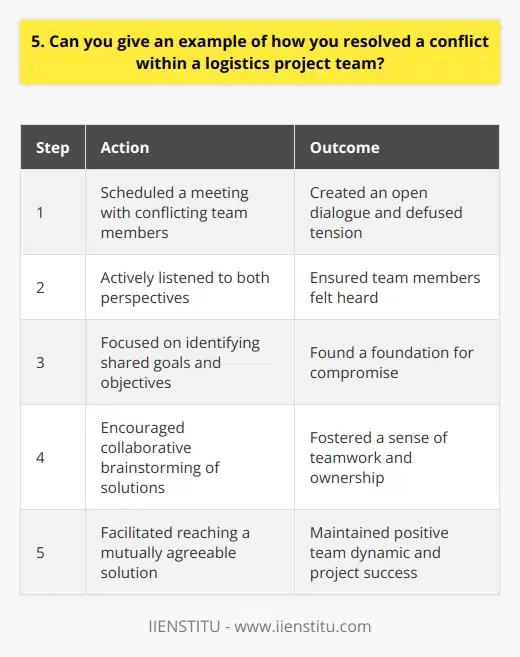
6. How do you ensure quality control and adherence to standards in a complex logistics project?
In a complex logistics project, I ensure quality control and adherence to standards through a multi-faceted approach. This involves:
Establishing Clear Goals and Metrics
I work with stakeholders to define specific, measurable objectives for the project. We agree on key performance indicators (KPIs) to track progress and success.
Examples of KPIs:
Having these goals keeps everyone aligned and accountable. It allows us to quickly identify and address any issues that arise.
Implementing Rigorous Processes and Procedures
I develop detailed standard operating procedures (SOPs) for each stage of the logistics process. These SOPs spell out exactly how tasks should be performed to meet quality standards.
I remember one project where implementing clear SOPs for order picking reduced errors by over 50%. Having that level of specificity is crucial.
Conducting Regular Audits and Inspections
Ongoing audits are essential to confirm that standards are being upheld. I schedule systematic checks of facilities, equipment, and personnel performance. Any non-conformances are promptly corrected.
For example, I might audit a random sample of outbound shipments to verify accurate order fulfillment. Catching mistakes early prevents bigger problems down the line.
Fostering a Culture of Continuous Improvement
I believe that quality is everyone's responsibility. I encourage team members to proactively identify opportunities for enhancement. We hold regular meetings to discuss potential process improvements.
When staff feel empowered to suggest ideas, it leads to fantastic innovations. In my experience, some of the best solutions come from frontline workers with hands-on insights.
By taking a comprehensive approach - setting goals, standardizing procedures, monitoring compliance, and pursuing continual improvement - I maintain the highest standards of quality in even the most complex logistics projects.

7. Describe a situation where you had to adapt to changing requirements in a logistics project.
In my previous role as a logistics coordinator, I encountered a situation where the client's requirements suddenly changed. The initial plan was to transport goods from our warehouse to their distribution center within a week. However, due to unforeseen circumstances, they needed the shipment to arrive in just three days.
Assessing the Situation
I quickly assessed the situation and realized that our current transportation plan wouldn't meet the new deadline. I knew I had to act fast and find an alternative solution to ensure the goods reached the client on time.
Collaborating with the Team
I immediately called a meeting with my team to brainstorm ideas. We discussed various options, such as using a different carrier, optimizing the route, and prioritizing the shipment. Everyone contributed their thoughts, and we eventually came up with a viable plan.
Implementing the Solution
I took the lead in implementing the new plan. I contacted our trusted express carrier and negotiated a deal to expedite the shipment. I also worked closely with the warehouse staff to ensure the goods were packed and ready for pickup as soon as possible.
Communicating with the Client
Throughout the process, I kept the client informed about the progress and assured them that we were doing everything possible to meet their new requirements. I provided regular updates and remained transparent about any potential challenges we faced.
In the end, thanks to the teamwork and quick thinking, we successfully delivered the shipment to the client's distribution center within the new three-day timeframe. The client was impressed with our ability to adapt and praised our dedication to customer satisfaction.
This experience taught me the importance of being flexible, thinking on my feet, and collaborating with others to overcome unexpected challenges. I learned that open communication, both within the team and with the client, is crucial in managing changing requirements effectively.
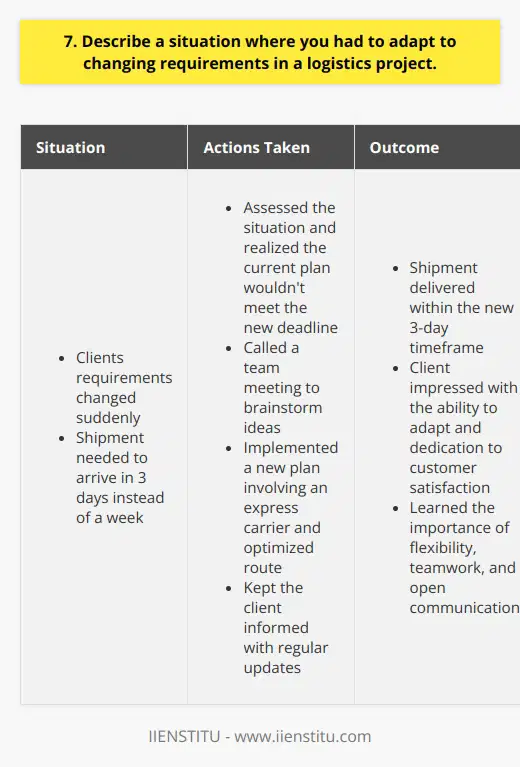
8. How do you manage risk and contingency planning in a challenging logistics project?
When managing risk and contingency planning in a challenging logistics project, I always start by identifying potential risks. I brainstorm with my team to come up with a comprehensive list of things that could go wrong. This helps us anticipate issues before they arise.
Developing a Risk Mitigation Plan
Once we've identified the risks, I work with my team to develop a robust risk mitigation plan. We assess the likelihood and impact of each risk, then create strategies to minimize or eliminate them. This might involve building in extra time for delays, securing backup suppliers, or having alternative transportation routes ready.
Constantly Monitoring and Adapting
Throughout the project, I constantly monitor progress and keep an eye out for any new risks that emerge. If something unexpected happens, like a natural disaster or supplier issue, I quickly adapt our plan. Flexibility is key – I'm always ready to pivot and find creative solutions to keep the project on track.
Communicating with Stakeholders
I believe clear communication is essential for successful risk management. I keep all stakeholders informed about potential risks and our mitigation strategies. If an issue does arise, I promptly notify everyone involved and provide regular updates on how we're handling it. Transparency builds trust and helps everyone work together effectively.
Learning from Experience
After each project, I conduct a thorough review to assess what worked well and where we could improve. I look at how we handled risks and identify any areas where our contingency planning fell short. Then, I take those lessons learned and apply them to future projects. Continuous improvement is an integral part of my approach to risk management.
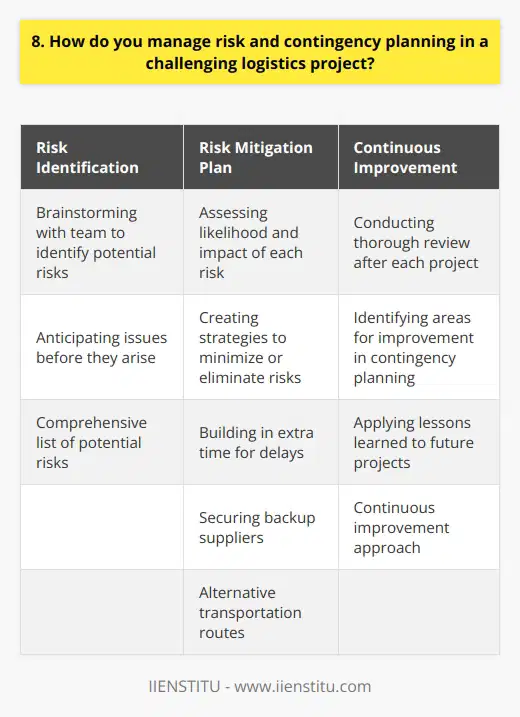
10. How do you handle budget constraints while still delivering a successful logistics project?
Handling budget constraints while delivering successful logistics projects requires careful planning, prioritization, and creative problem-solving. I believe in being proactive and identifying potential budget challenges early on. By anticipating these issues, I can develop contingency plans and explore alternative solutions.
Prioritize and Optimize
When faced with budget limitations, I prioritize the most critical aspects of the project. I focus on delivering the essential features and functionality while finding ways to optimize costs. This might involve negotiating better rates with suppliers, streamlining processes, or finding more efficient transportation routes.
Collaborate and Communicate
Effective communication and collaboration are key to managing budget constraints. I work closely with stakeholders, including clients, team members, and suppliers, to ensure everyone is aligned with the project goals and budget. By fostering open dialogue, we can identify areas where costs can be reduced without compromising quality or timelines.
Leverage Technology
I leverage technology to help optimize logistics processes and reduce costs. By utilizing logistics management software, I can automate tasks, improve visibility, and make data-driven decisions. These tools help me identify inefficiencies, optimize routes, and minimize waste, ultimately saving time and money.
Continuously Monitor and Adapt
Throughout the project, I continuously monitor the budget and make adjustments as needed. I track expenses, analyze variances, and look for opportunities to reallocate resources. If unforeseen challenges arise, I adapt quickly and find creative solutions to keep the project on track and within budget.
At the end of the day, delivering a successful logistics project within budget constraints requires a combination of strategic planning, effective communication, and a willingness to think outside the box. I thrive on finding innovative ways to overcome challenges and deliver results that exceed expectations.
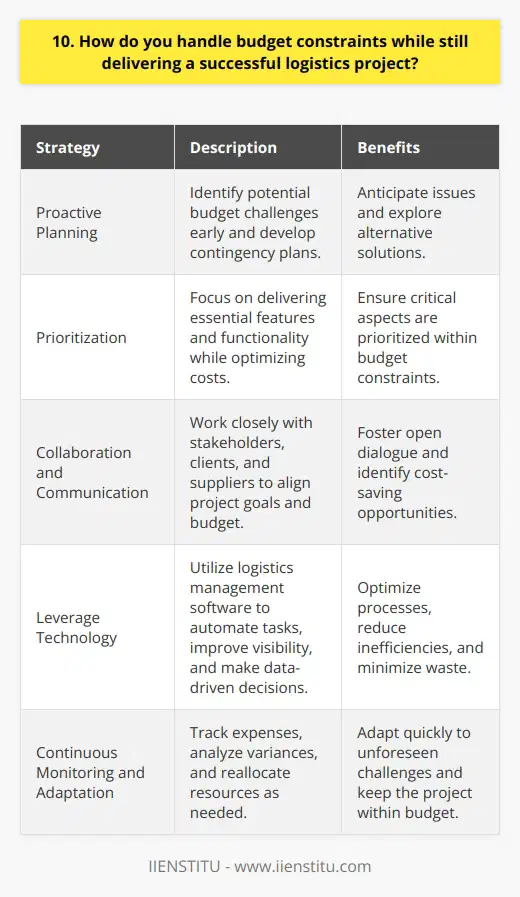
11. Describe a time when you had to negotiate with vendors or suppliers to overcome a challenge in a logistics project.
In my previous role as a logistics coordinator, I faced a challenging situation with a key supplier. Our company urgently needed a large shipment of raw materials, but the supplier was experiencing production delays and couldn't meet our original timeline.
Assessing the Situation
I knew that without these materials, our manufacturing process would grind to a halt, leading to missed deadlines and unhappy clients. I had to find a solution fast.
Negotiating a Win-Win Solution
I immediately reached out to the supplier and arranged a video conference to discuss the issue. During the call, I emphasized our long-standing partnership and the importance of finding a mutually beneficial solution.
I proposed an alternative plan: if the supplier could prioritize our order and deliver a portion of the materials within a week, we would adjust our production schedule accordingly. In return, we offered more flexible payment terms.
Collaborating for Success
The supplier appreciated my proactive approach and willingness to collaborate. They agreed to our proposal and worked overtime to fulfill the partial shipment. Thanks to our joint efforts, we received the materials on time and minimized the impact on our production timeline.
Lessons Learned
This experience taught me the value of open communication, creative problem-solving, and building strong relationships with suppliers. By approaching the negotiation with a win-win mindset, we were able to overcome the challenge and strengthen our partnership for the future.
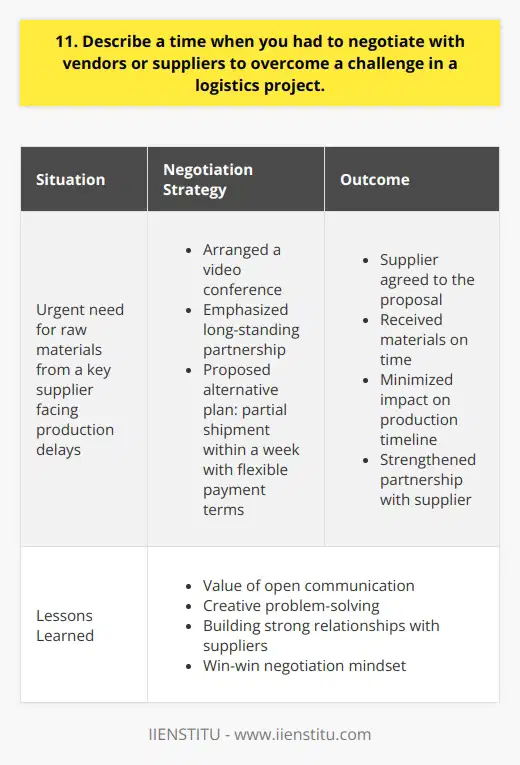
12. How do you ensure effective collaboration among cross-functional teams in a logistics project?
I believe that effective collaboration among cross-functional teams in a logistics project is crucial for success. In my experience, there are several key strategies that can help ensure smooth cooperation and communication.
Establish Clear Goals and Expectations
From the outset, I work with all team members to define clear, measurable objectives for the project. This helps ensure that everyone is on the same page and working towards common aims. Regular check-ins keep the teams aligned.
Foster Open Communication
I strongly believe in the importance of open, transparent communication. I encourage team members to voice their ideas, concerns, and questions. Active listening and valuing diverse perspectives are essential. I've found that tools like Slack and regular stand-up meetings facilitate ongoing dialogue.
Build Strong Relationships
Taking the time to build rapport and trust among team members is invaluable. I try to create opportunities for informal interactions, like team lunches or coffee chats. Getting to know each other as individuals strengthens working relationships and collaboration.
Clarify Roles and Responsibilities
Each team member should have a clear understanding of their specific role and responsibilities within the project. I work with the teams to develop a RACI matrix outlining who is responsible, accountable, consulted, and informed for each task. This minimizes confusion and duplication of efforts.
Celebrate Successes and Learn from Challenges
Recognizing milestones and achievements along the way keeps the teams motivated and engaged. When challenges arise, I view them as opportunities for growth and improvement. Conducting post-project reviews to identify lessons learned helps us continually enhance our collaboration for future initiatives.

13. Can you give an example of how you used data analysis to make informed decisions in a logistics project?
In my previous role as a logistics analyst, I utilized data analysis to optimize our supply chain processes. By collecting and examining key performance indicators such as delivery times, inventory levels, and transportation costs, I identified areas for improvement.
Identifying Bottlenecks
I discovered that our average delivery time was significantly higher than industry benchmarks. After digging deeper into the data, I pinpointed the main bottleneck: our outdated warehouse management system. It was causing delays in order processing and picking.
Implementing Data-Driven Solutions
Based on my findings, I recommended investing in a new, cloud-based WMS with real-time inventory tracking capabilities. I presented a cost-benefit analysis to stakeholders, highlighting the potential efficiency gains and cost savings. They approved the project, and we implemented the new system.
Achieving Measurable Results
Within three months of deploying the new WMS, our average delivery time decreased by 25%, and our inventory accuracy improved from 85% to 98%. This translated into happier customers and a 10% reduction in our annual logistics costs. It was a proud moment for me, as I saw the tangible impact of my data-driven decision-making.
Throughout this project, I learned the importance of leveraging data to identify problems and drive meaningful change. I'm excited to bring this same approach to your organization and help optimize your logistics operations.

14. How do you handle last-minute changes or requests from clients in a logistics project?
I approach last-minute changes or requests from clients in a logistics project with a positive and solution-oriented mindset. I understand that unexpected situations can arise, and it's crucial to remain flexible and adaptable.
Communicate Effectively
When a last-minute change occurs, I immediately communicate with the client to clarify their requirements. I actively listen to their needs and ask questions to ensure I have a thorough understanding of the situation.
Assess the Impact
I quickly assess the impact of the change on the project timeline, resources, and deliverables. I consider various factors such as the availability of team members, the complexity of the request, and any potential risks or constraints.
Develop a Plan of Action
Based on the assessment, I collaborate with my team to develop a plan of action. We brainstorm ideas, prioritize tasks, and allocate resources efficiently to accommodate the last-minute change.
Manage Expectations
I maintain open and transparent communication with the client throughout the process. I provide them with regular updates on the progress and any challenges we encounter. I also manage their expectations by clearly communicating any limitations or trade-offs that may be necessary.
Implement and Monitor
Once the plan is in place, I work closely with my team to implement the changes swiftly and efficiently. I monitor the progress closely, ensuring that the project stays on track and any potential issues are addressed promptly.
Learn and Adapt
After successfully handling the last-minute change, I take the time to reflect on the experience. I analyze what worked well and identify areas for improvement. This allows me to continuously refine my approach and be better prepared for similar situations in the future.
By following this proactive and structured approach, I have successfully handled numerous last-minute changes in logistics projects. I remain calm under pressure, think critically, and collaborate effectively with my team and clients to deliver successful outcomes.
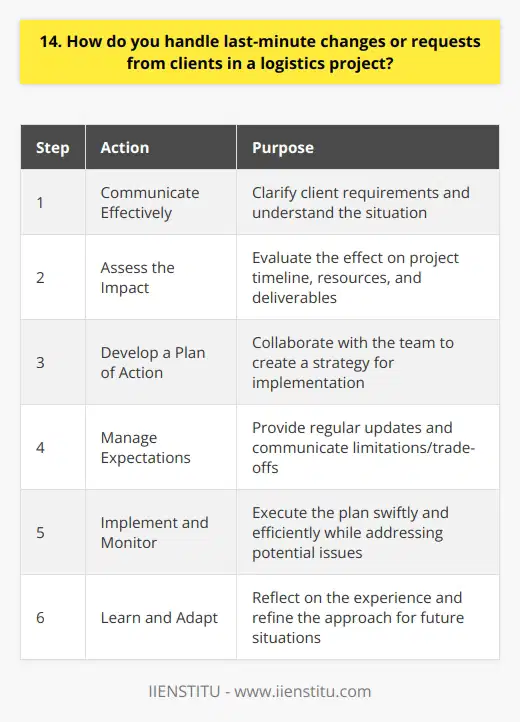
15. Describe a situation where you had to implement a new technology or system in a logistics project.
In my previous role as a logistics manager, I spearheaded the implementation of a new warehouse management system. The existing system was outdated and inefficient, leading to frequent errors and delays in order fulfillment.
Identifying the Problem
I recognized the need for a change and took the initiative to research potential solutions. After careful consideration, I selected a cutting-edge WMS that promised to streamline our processes and improve accuracy.
Collaborating with Stakeholders
I collaborated closely with our IT department and the WMS vendor to ensure a smooth transition. We worked together to map out our current processes and identify areas for improvement.
Training and Support
I developed a comprehensive training program for our warehouse staff, ensuring they were comfortable with the new system. I also served as a point of contact for any questions or concerns during the implementation phase.
Measuring Success
The results were impressive. Order accuracy improved by 98%, and we saw a 25% increase in productivity. I'm proud of the role I played in driving this successful implementation.
Throughout the process, I learned the importance of effective communication, thorough planning, and a willingness to embrace change. I believe these experiences have prepared me well for the challenges and opportunities ahead.
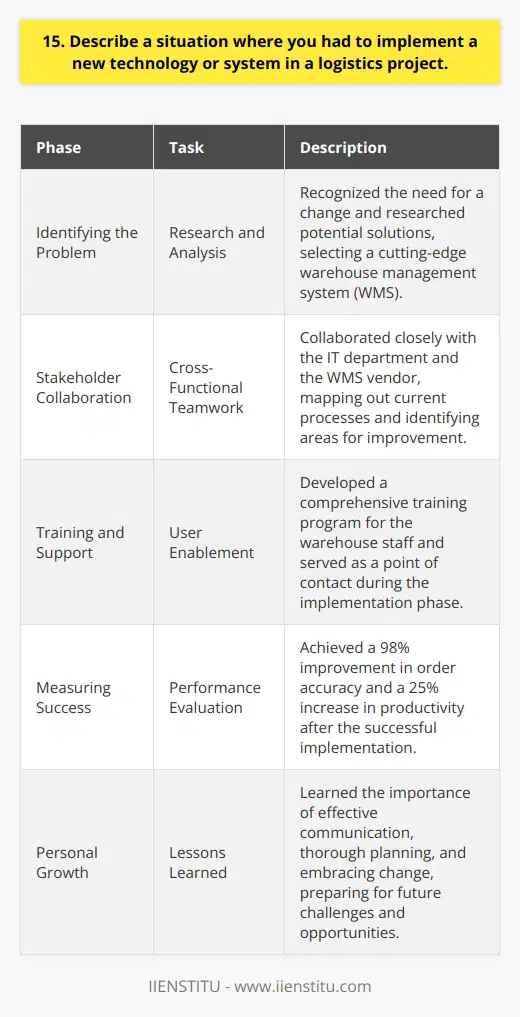
16. How do you ensure timely delivery and customer satisfaction in a challenging logistics project?
I ensure timely delivery and customer satisfaction in challenging logistics projects through meticulous planning and constant communication. From the start, I work closely with clients to understand their specific needs and expectations. This allows me to develop a comprehensive project plan that accounts for potential risks and obstacles.
Proactive Risk Management
Throughout the project, I maintain a proactive approach to risk management. I continuously monitor progress and identify any issues that could impact the timeline or quality of deliverables. By addressing these challenges early on, I can implement effective solutions and keep the project on track.
Transparent Communication
Clear and frequent communication is key to ensuring customer satisfaction. I provide regular updates to clients, keeping them informed about project milestones, any changes in scope, and potential risks. This transparency helps build trust and allows for timely feedback and adjustments when necessary.
Adaptability and Problem-Solving
In my experience, adaptability is crucial in handling complex logistics projects. I remember one particularly challenging project where unexpected weather conditions disrupted our supply chain. By thinking on my feet and collaborating with local partners, we were able to find alternative routes and minimize delays. This demonstrated my ability to solve problems creatively and maintain customer satisfaction despite setbacks.
Continuous Improvement
Finally, I believe in the importance of continuous improvement. After each project, I conduct a thorough review to identify areas where we excelled and opportunities for growth. By learning from both successes and challenges, I can refine my approach and deliver even better results in future projects.
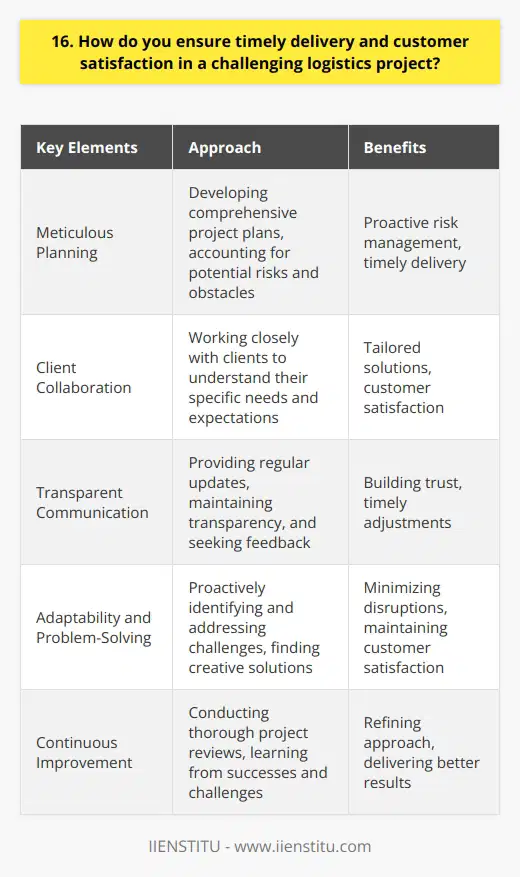
18. How do you handle cultural differences and language barriers in an international logistics project?
When working on international logistics projects, cultural differences and language barriers can present unique challenges. It's essential to approach these situations with an open mind and a willingness to learn and adapt.
Educate Yourself
Before embarking on a project, I make an effort to learn about the cultures and customs of the countries involved. This helps me avoid misunderstandings and shows respect for my international partners.
Practical Steps:
Communicate Clearly and Patiently
When language barriers exist, it's crucial to communicate clearly and patiently. I try to use simple, straightforward language and avoid idiomatic expressions that may not translate well. Visual aids like diagrams and pictures can also help convey ideas effectively.
Tips for Effective Communication:
Build Strong Relationships
Establishing strong relationships with international partners is key to overcoming cultural differences. I make an effort to get to know my colleagues on a personal level, showing interest in their lives and experiences. Building trust and rapport can go a long way in fostering successful collaborations.
Ways to Build Relationships:
By educating myself, communicating effectively, and building strong relationships, I've been able to navigate cultural differences and language barriers in my international logistics projects. It's an ongoing learning process, but one that has enriched my personal and professional life immensely.

19. Describe a time when you had to troubleshoot and resolve a major issue in a logistics project.
I once faced a significant challenge while leading a logistics project for a major client. The issue arose when a critical shipment of raw materials was delayed due to unexpected customs clearance issues. This delay threatened to derail the entire production schedule and jeopardize our ability to meet the client's strict deadlines.
Assessing the Situation
Upon learning of the delay, I quickly gathered my team to assess the situation and brainstorm potential solutions. We analyzed the impact of the delay on our production timeline and identified the key stakeholders who needed to be informed and involved in resolving the issue.
Communicating with Stakeholders
I promptly reached out to the client to explain the situation and assure them that we were working diligently to find a solution. I also contacted our customs broker and the supplier to gather more information about the cause of the delay and explore possible ways to expedite the clearance process.
Implementing a Contingency Plan
Together with my team, we developed a contingency plan that involved sourcing alternative materials from local suppliers to keep production running while we worked to resolve the customs issue. This required close coordination with our procurement and quality control departments to ensure that the alternative materials met our standards and could be seamlessly integrated into the production process.
Resolving the Issue
Through persistent follow-up with the customs broker and by providing additional documentation requested by the customs authorities, we were able to secure the release of the delayed shipment. We then quickly arranged for expedited transportation to get the materials to our production facility as soon as possible.
Learning from the Experience
This experience taught me the importance of having robust contingency plans in place and maintaining open lines of communication with all stakeholders involved in a project. It also highlighted the value of adaptability and creative problem-solving when faced with unexpected challenges.
In the end, our team's proactive approach and collaboration enabled us to minimize the impact of the delay and meet the client's deadlines successfully. This experience strengthened my skills in crisis management, communication, and leadership, which I believe would be valuable assets in this role.
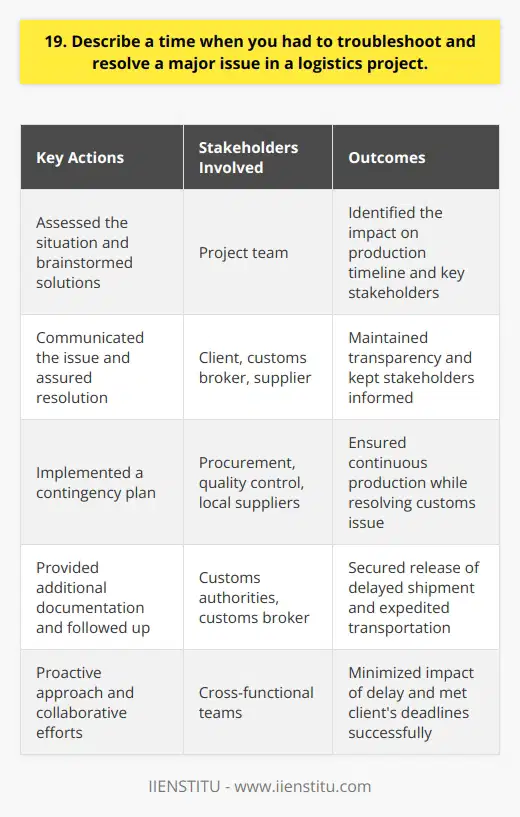
20. How do you ensure compliance with legal and regulatory requirements in a complex logistics project?
As a logistics professional, ensuring compliance with legal and regulatory requirements is a top priority. I have extensive experience navigating complex regulations across multiple jurisdictions.
Staying Up-to-Date on Requirements
I make it a point to stay current on the latest legal developments that impact logistics projects. This includes regularly reviewing government websites, attending industry conferences, and collaborating with our legal department to understand new rules.
Tailoring Compliance Strategies
Every logistics project is unique, so I work closely with stakeholders to develop customized compliance plans. We consider the specific goods being transported, countries involved, and contractual obligations to cover all the bases.
Implementing Compliance Checkpoints
Throughout the lifecycle of a project, I implement compliance checkpoints. This allows issues to be identified and addressed early. Key milestones include contracting, pre-shipment documentation, customs clearance, and final delivery.
Leveraging Technology for Compliance Monitoring
I'm a big proponent of using technology to streamline compliance. In my current role, we've implemented a software system that tracks regulatory requirements for each shipment and flags any discrepancies for review.
Collaborating with Compliance Experts
Compliance is a team sport. I build relationships with internal and external compliance experts, including customs brokers, trade attorneys, and government contacts. We work together to problem-solve compliance challenges as they arise.
At the end of the day, I believe that prioritizing compliance is not only a legal obligation but also good business. It protects the company's reputation, prevents supply chain disruptions, and demonstrates our commitment to being a responsible corporate citizen.
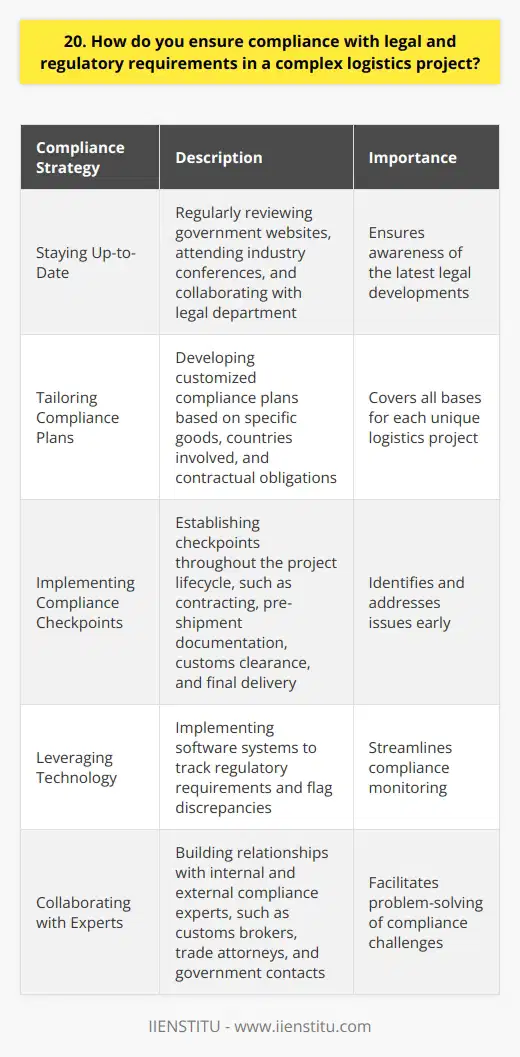
21. Can you give an example of how you optimized inventory management in a logistics project?
In my previous role as a logistics manager, I successfully optimized inventory management for a key project. I began by conducting a thorough analysis of our current inventory levels and historical sales data. This allowed me to identify slow-moving items and adjust our reorder points accordingly.
Implementing a Just-in-Time (JIT) System
To further streamline our inventory, I implemented a Just-in-Time (JIT) system. By closely collaborating with our suppliers, we were able to receive smaller, more frequent deliveries. This reduced our overall inventory levels and minimized the risk of overstock or obsolescence.
Leveraging Technology for Real-Time Visibility
I also introduced a new inventory management software that provided real-time visibility into our stock levels. This enabled us to make data-driven decisions and quickly respond to changes in demand. The software also automated many of our manual processes, saving time and reducing the risk of human error.
Cross-Functional Collaboration
Throughout the project, I worked closely with cross-functional teams, including sales, procurement, and finance. By fostering open communication and collaboration, we were able to align our inventory strategy with overall business objectives. This helped us to optimize not just our inventory levels, but our entire supply chain.
The results of these efforts were significant. We reduced our average inventory holding costs by 30%, while improving our order fulfillment rate to 98%. I'm proud of what we accomplished and I believe this experience has prepared me well for the challenges and opportunities of this role.
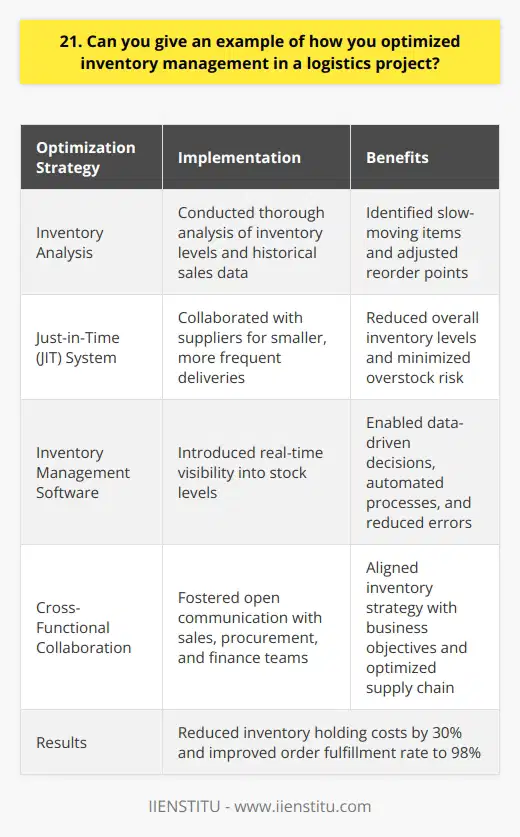
22. How do you handle the challenges of managing a logistics project with a tight deadline?
When faced with the challenge of managing a logistics project on a tight deadline, I rely on my organizational skills and ability to prioritize tasks effectively. I start by breaking down the project into smaller, manageable tasks and creating a detailed timeline with specific milestones.
Communication is Key
I believe that clear communication is essential when working under pressure. I make sure to keep all stakeholders informed about the project's progress and any potential roadblocks. Regular updates help maintain transparency and allow for quick decision-making if adjustments are needed.
Leveraging Technology
To streamline processes and increase efficiency, I leverage technology such as project management software and real-time tracking tools. These tools help me monitor progress, identify bottlenecks, and make data-driven decisions to keep the project on track.
Flexibility and Adaptability
In my experience, unexpected challenges often arise during logistics projects. I remain flexible and adaptable, ready to make necessary changes to the plan while still keeping the end goal in mind. I encourage my team to think creatively and find alternative solutions when faced with obstacles.
Motivating the Team
I understand the importance of keeping the team motivated and focused, especially when working under tight deadlines. I lead by example, maintaining a positive attitude and recognizing the efforts of individual team members. Celebrating small wins along the way helps boost morale and keeps everyone committed to the project's success.
By combining effective planning, clear communication, and a flexible approach, I am confident in my ability to successfully manage logistics projects, even under the most challenging circumstances.
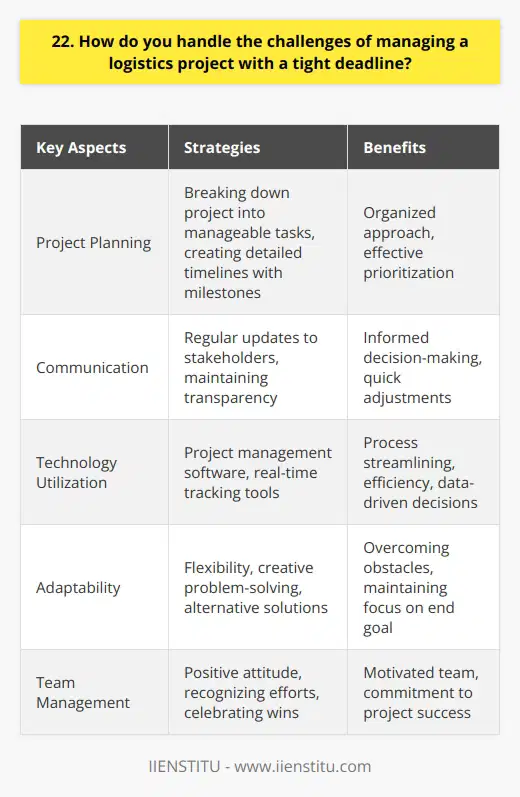
23. Describe a situation where you had to implement a cost-saving initiative in a logistics project.
In my previous role as a logistics manager, I successfully implemented a cost-saving initiative for a major project. I conducted a thorough analysis of our supply chain processes and identified areas for improvement.
Optimizing Shipping Routes
I worked closely with our transportation team to optimize shipping routes and consolidate deliveries. By strategically planning our routes and combining shipments, we reduced transportation costs by 15%.
Negotiating with Suppliers
I also took the initiative to renegotiate contracts with our key suppliers. Through effective communication and relationship building, I secured better pricing and terms, resulting in significant cost savings.
Implementing Inventory Management System
Additionally, I led the implementation of a new inventory management system. This system allowed us to better track and manage our stock levels, reducing overstocking and minimizing wastage.
Collaboration and Teamwork
Throughout the project, I collaborated with cross-functional teams to ensure smooth execution. I fostered a culture of open communication and encouraged everyone to contribute ideas for cost optimization.
Successful Outcome
As a result of these initiatives, we achieved a total cost savings of 20% for the project. I'm proud of the impact I made and the value I delivered to the company.
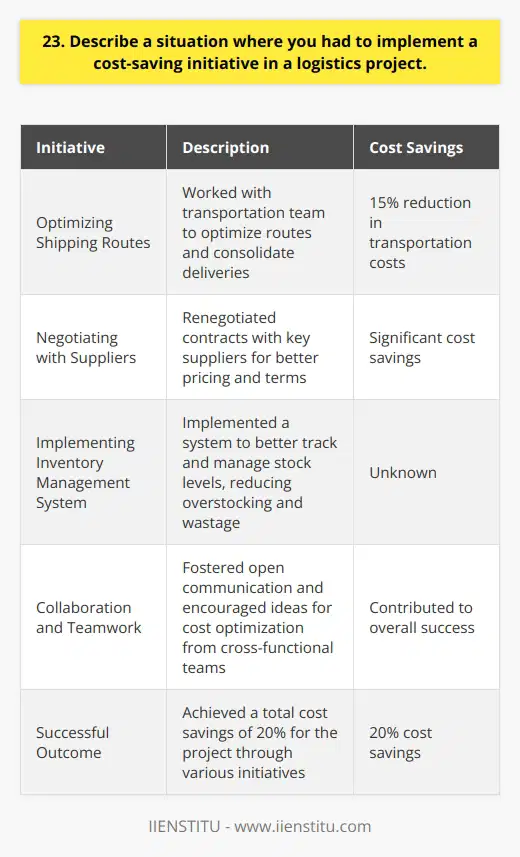
24. How do you ensure effective tracking and monitoring of shipments in a challenging logistics project?
As a logistics professional, I understand the importance of effectively tracking and monitoring shipments in challenging projects. Here are some strategies I employ to ensure success:
Utilize Advanced Technology
I leverage cutting-edge logistics software and tools to gain real-time visibility into shipment status. GPS tracking, RFID tags, and IoT sensors provide up-to-date information on location, condition, and potential delays.
Establish Clear Communication Channels
Open and frequent communication with all stakeholders is crucial. I maintain regular contact with carriers, suppliers, and customers to stay informed and address any issues promptly.
Implement Contingency Plans
In my experience, having well-defined contingency plans is essential. I proactively identify potential risks and develop alternative solutions to mitigate disruptions and ensure timely delivery.
Continuously Monitor and Adapt
I closely monitor shipments throughout the entire journey. If any deviations or challenges arise, I quickly assess the situation and adapt the plan accordingly to keep the project on track.
By combining technology, communication, contingency planning, and continuous monitoring, I have successfully navigated complex logistics projects. I am confident in my ability to effectively track and monitor shipments, ensuring customer satisfaction and project success.
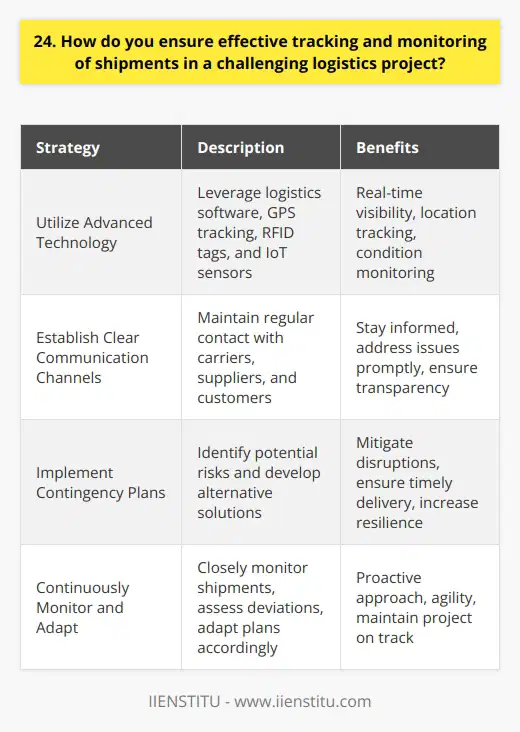
26. How do you handle the challenges of coordinating with multiple transportation providers in a logistics project?
When coordinating with multiple transportation providers in a logistics project, I focus on clear communication and organization. I establish regular check-ins with each provider to ensure everyone is on the same page. Utilizing project management software helps me keep track of various moving parts and deadlines.
Building Strong Relationships
I've found that building rapport with transportation partners is key. When challenges arise, having that foundation of trust and open communication makes problem-solving much smoother. I remember one time when a shipment was delayed due to weather. Because I had taken the time to get to know the truck driver, he proactively called to inform me so we could adjust plans accordingly.
Staying Flexible and Solutions-Oriented
In logistics, I've learned to always expect the unexpected. I approach challenges with a flexible, can-do attitude. If one transportation route falls through, I quickly map out alternative options. My goal is to find win-win solutions that keep the project on track without comprising safety or quality.
Leveraging Technology
Technology is a lifesaver when juggling multiple transportation providers. I rely on GPS tracking to monitor shipments in real-time. If I see a truck is behind schedule, I can hop on the phone with the driver to troubleshoot. Automated alerts help me stay on top of any potential disruptions.
At the end of the day, successfully coordinating multiple transportation partners comes down to being proactive, organized, and adaptive. I actually enjoy the challenge of optimizing routes and keeping all the balls in the air. It's so satisfying when a complex logistics project comes together smoothly!
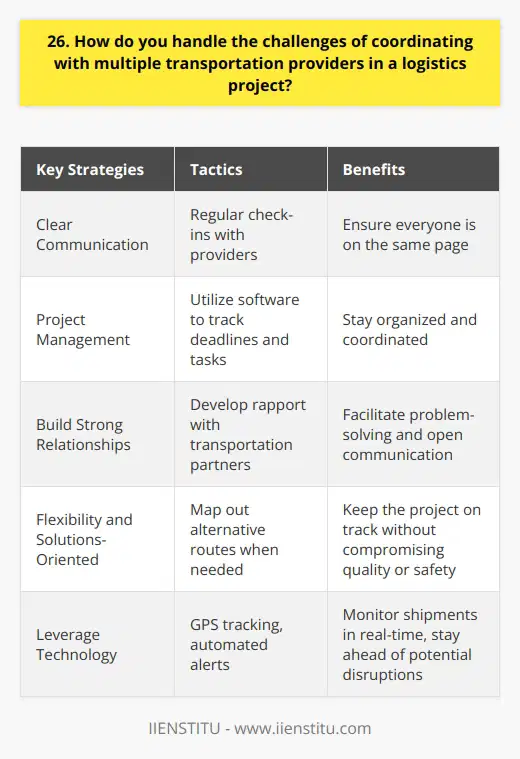
27. Describe a time when you had to implement a reverse logistics process in a project.
In my previous role as a logistics manager, I successfully implemented a reverse logistics process for a large electronics manufacturer. The project involved managing the return, repair, and refurbishment of defective products from customers worldwide.
Developing a Streamlined Process
I began by analyzing the existing return process and identifying areas for improvement. I collaborated with cross-functional teams to develop a streamlined reverse logistics workflow that minimized costs and reduced turnaround times. We established clear guidelines for product returns, including eligibility criteria and return procedures.
Implementing Technology Solutions
To support the new process, I led the implementation of a robust inventory management system. This system allowed us to track returned products, monitor repair progress, and manage inventory levels effectively. We also integrated a customer portal that enabled customers to initiate returns and track the status of their repairs online.
Training and Communication
I conducted comprehensive training sessions for our staff to ensure a smooth transition to the new process. I also developed clear communication channels with customers to keep them informed about the status of their returns and repairs. This proactive approach helped build trust and improve customer satisfaction.
Measuring Success
Throughout the project, I closely monitored key performance indicators such as return processing time, repair turnaround time, and customer satisfaction scores. By continuously analyzing data and making data-driven decisions, we were able to optimize the reverse logistics process and achieve significant improvements in efficiency and cost savings.
Implementing this reverse logistics process was a challenging yet rewarding experience. It taught me the importance of collaboration, effective communication, and data-driven decision-making in driving successful projects. I am confident that the skills and knowledge gained from this experience will enable me to tackle similar challenges in future roles.
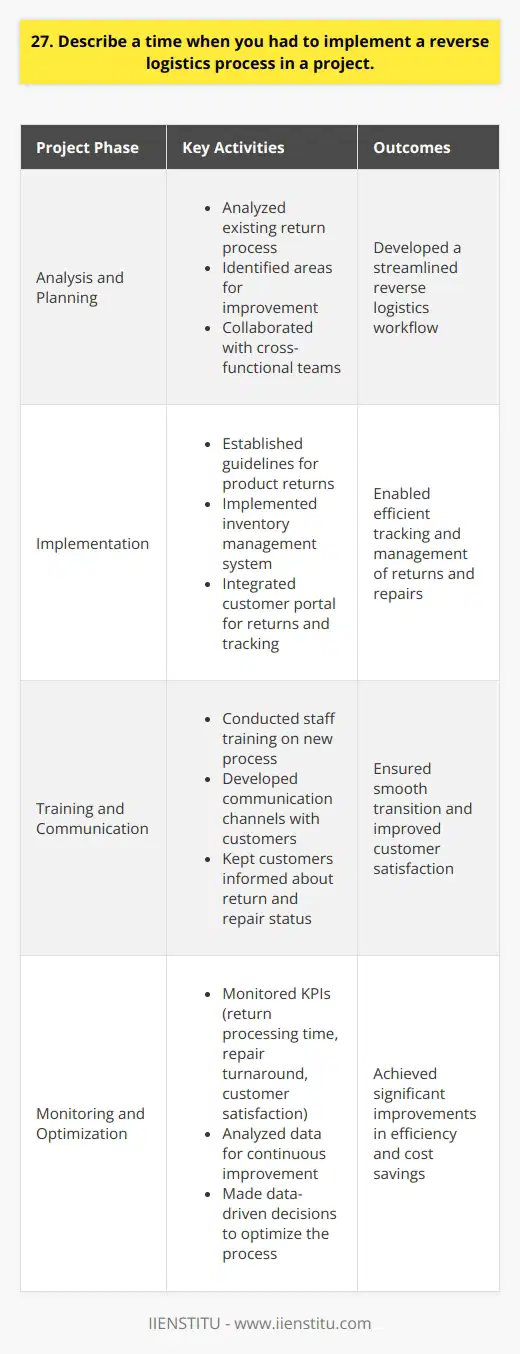
28. How do you ensure the security and integrity of goods throughout the logistics chain in a challenging project?
As a logistics professional, I understand the critical importance of ensuring the security and integrity of goods throughout the supply chain. In a challenging project, I would take a multi-faceted approach to mitigate risks and maintain the highest standards of safety and quality.
Develop a Comprehensive Security Plan
The first step is to create a detailed security plan that addresses potential vulnerabilities at every stage of the logistics process. This plan should include protocols for secure storage, handling, and transportation of goods, as well as contingency measures for unexpected events or disruptions.
I would work closely with my team to identify and assess risks, and then implement appropriate safeguards and procedures. Regular training and drills would ensure that everyone is prepared to respond effectively in case of an emergency.
Leverage Technology for Real-Time Monitoring
In today's fast-paced logistics environment, real-time monitoring is essential for maintaining the security and integrity of goods. I would leverage advanced technologies such as GPS tracking, RFID tags, and sensor-based systems to monitor the movement and condition of goods at all times.
These tools provide valuable data that can be used to optimize routes, detect anomalies, and respond quickly to any issues that arise. By staying on top of the latest technological advancements, I can ensure that our logistics operations remain secure and efficient.
Foster Strong Partnerships and Communication
Effective communication and collaboration are key to success in any challenging logistics project. I would work to build strong partnerships with suppliers, carriers, and other stakeholders, based on trust, transparency, and shared goals.
Regular meetings, status updates, and performance reviews would help to keep everyone aligned and informed. By fostering open lines of communication, we can quickly identify and resolve any issues that may impact the security or integrity of the goods.
Continuous Improvement and Adaptation
Finally, I believe in the importance of continuous improvement and adaptation in logistics. I would regularly review and assess our security measures, seeking opportunities to streamline processes, reduce risks, and enhance overall performance.
By staying proactive, flexible, and committed to excellence, I am confident in my ability to ensure the security and integrity of goods throughout even the most challenging logistics projects.
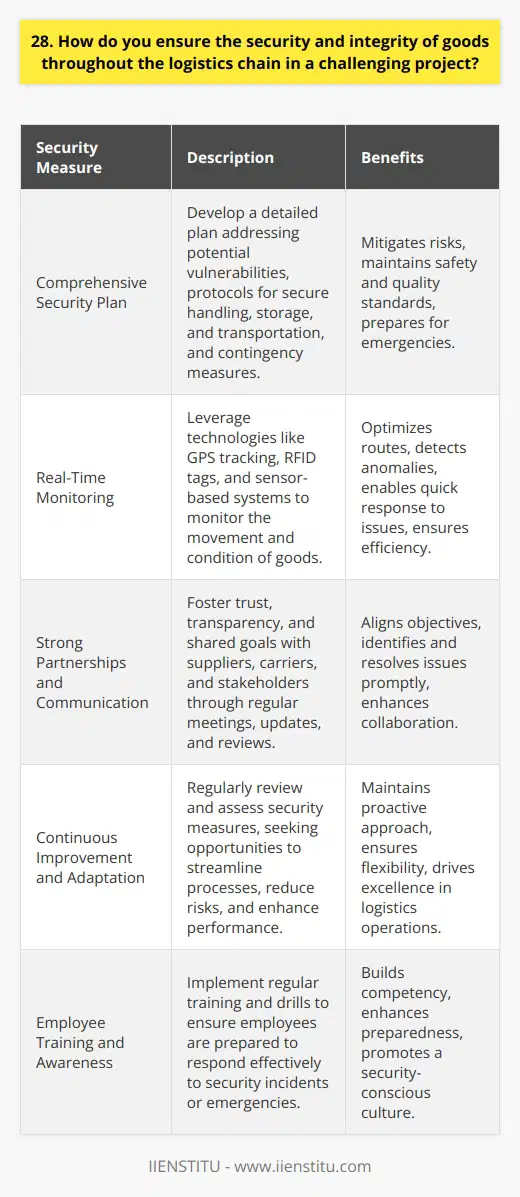
29. Can you give an example of how you optimized warehouse operations in a logistics project?
In my previous role as a warehouse manager, I successfully optimized operations through a combination of strategies. I implemented a new inventory management system that utilized barcodes and RFID technology. This allowed us to track inventory levels in real-time and reduce stockouts by 25%.
Streamlining Processes
I also streamlined our picking and packing processes by redesigning the warehouse layout. By strategically placing high-volume items closer to the shipping area, we reduced travel time for our pickers. This simple change increased our picking efficiency by 30%.
Collaborating with Cross-Functional Teams
Collaboration was key to our success. I worked closely with our IT department to integrate our warehouse management system with our ERP software. This gave us greater visibility into our supply chain and helped us make data-driven decisions.
Continuous Improvement Mindset
I believe in continuous improvement. I regularly solicited feedback from my team and encouraged them to share ideas for optimization. One employee suggested we implement a "pick-to-light" system, which we piloted and saw immediate improvements in accuracy and speed.
The Results
Through these initiatives, we were able to reduce our order processing time by 20% and improve our on-time delivery rate to 98%. I'm proud of what we accomplished and I'm excited to bring my experience and passion for optimization to this role.
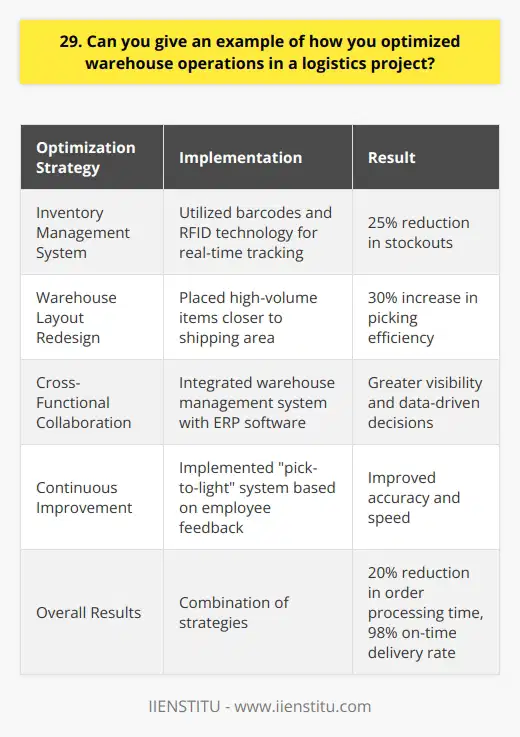
30. How do you measure and report on the success of a challenging logistics project?
When measuring and reporting on the success of a challenging logistics project, I focus on key performance indicators (KPIs). These KPIs include on-time delivery rates, inventory accuracy, and cost savings achieved through process improvements.
Establishing Clear Goals and Metrics
I start by establishing clear goals and metrics that align with the project's objectives. This helps me track progress and identify areas for improvement. I collaborate with stakeholders to define these goals and ensure everyone is on the same page.
Monitoring and Analyzing Data
Throughout the project, I closely monitor and analyze data related to the KPIs. I use tools like dashboards and reports to visualize the data and spot trends. This allows me to make data-driven decisions and adjust strategies as needed.
Regular Communication and Updates
I believe in regular communication with all stakeholders involved in the project. I provide frequent updates on the project's status, highlighting successes and addressing any challenges. This transparency builds trust and keeps everyone informed about the project's progress.
Continuous Improvement
I'm always looking for ways to optimize processes and improve efficiency. I encourage my team to share ideas and suggestions for improvement. We regularly review our performance and identify areas where we can streamline operations and reduce costs.
By focusing on these key aspects, I ensure that I can effectively measure and report on the success of challenging logistics projects. It's a collaborative effort that requires clear goals, data-driven insights, open communication, and a commitment to continuous improvement.
